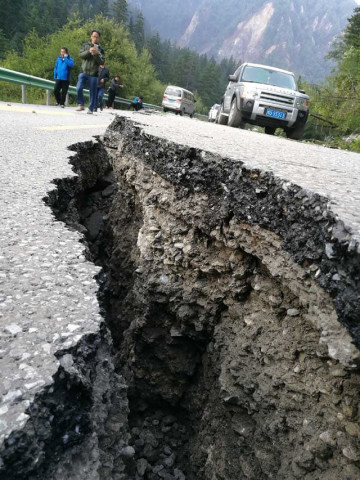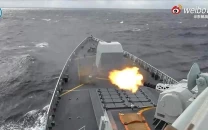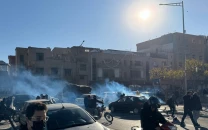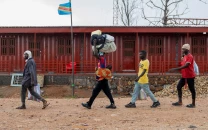Nearly 60,000 evacuated after China quake kills 19
Earthquake of 6.5 magnitude hit the Sichuan city on Tuesday

A crack, caused by an earthquake, is seen on a road in Jiuzhaigou in China's southwestern Sichuan province on August 9, 2017. PHOTO: AFP
The 6.5-magnitude earthquake struck Sichuan province late on Tuesday, tearing cracks in mountain highways, triggering landslides, damaging buildings and sending panicked residents and tourists fleeing into the open.
The quake killed at least 19 people and injured at least 247, 40 of them seriously, according to the local government of Aba prefecture where the epicentre was located.
Two foreign nationals, a French man and a Canadian woman, are among the injured.
Images on social media or in state news outlets showed cars and buses tossed into ravines or crushed by giant boulders jolted loose from surrounding hills, and rescue personnel combing through rubble for any victims.

The quake's epicentre was near Jiuzhaigou, a national park and UNESCO World Heritage Site famed for its karst rock formations, waterfalls and lakes.
Xinhua said at least five of the deaths occurred there, and that more than 30,000 people had been evacuated from Jiuzhaigou alone.
"Nearly all the tourists are being evacuated," a Jiuzhaigou tour company worker who gave only her surname, Yan, said.
"We slept overnight in tour buses and have been staying in the open ground. Landslides are pretty bad, rocks keep falling down."
China's official earthquake monitoring agency said more than 1,000 aftershocks had been detected, the most powerful reaching magnitude 4.8 on Wednesday morning.
The Xinjiang quake, which was followed by aftershocks of 5.2 and 5.3 magnitude, injured 32 people and damaged more than 1,000 homes, Xinhua said.
President Xi Jinping called for "all-out efforts to rapidly organise relief work and rescue the injured" in the Sichuan quake.
Hundreds of soldiers and rescue personnel had been deployed to the Jiuzhaigou area, along with hundreds of vehicles, and dozens of sniffer dogs and devices used to detect life underneath rubble.
A stream of empty tour buses bearing the sign "Emergency Rescue Vehicle" made their way across the highway toward the disaster zone Wednesday afternoon.
The quake struck at a shallow depth of 10 kilometres, the USGS said, and was reportedly felt hundreds of kilometres from the epicentre. Shallow quakes tend to cause more surface damage.
It evoked memories of a massive 8.0-magnitude earthquake that devastated wide areas of the same region in 2008, leaving 87,000 people dead or missing in China's worst seismic disaster in a generation.
"I was also in Jiuzhaigou in 2008 during the last big quake, so I knew what it was. This felt even stronger," local restaurant owner Tang Sesheng said. "People didn't dare grab anything like money or clothes - we just all ran outside right away."
Several people reported seeing some structures collapse. Others, speaking from the road amid an exodus on traffic-choked mountain highways, reported cars being hit by persistent rockfalls in the quake's aftermath.
The 2008 quake set off deadly landslides in the region, obliterating towns and damming rivers - creating menacing "quake lakes" that forced the evacuation of thousands downstream as the army worked to clear the blockages.
The Red Cross Society of China said it was sending emergency specialists and volunteers, while Save the Children was also mobilising teams.
"Given the frequent landslides in the rainy season and potential massive secondary disaster following the big earthquake, Save the Children is deeply concerned about the safety of children and women in the affected areas," said the charity's operations director in China, Zhang Hongxia.












1726134115-0/BeFunk_-(41)1726134115-0-208x130.webp)






COMMENTS
Comments are moderated and generally will be posted if they are on-topic and not abusive.
For more information, please see our Comments FAQ